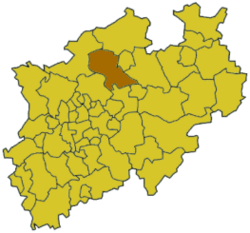Coesfeld Rural District facts for kids
Quick facts for kids
Coesfeld
|
|
|---|---|
 |
|
| Country | |
| State | North Rhine-Westphalia |
| Adm. region | Münster |
| Capital | Coesfeld |
| Area | |
| • Total | 1.109,79 km2 (0.42849 sq mi) |
| Population
(2002)
|
|
| • Total | 217.632 |
| • Density | 196.1020/km2 (507.902/sq mi) |
| Time zone | UTC+1 (CET) |
| • Summer (DST) | UTC+2 (CEST) |
| Vehicle registration | COE |
| Website | http://www.kreis-coesfeld.de |
Coesfeld is a Kreis, which is like a district or region, located in the northwestern part of North Rhine-Westphalia, Germany. It's situated to the west of the larger city of Münster. This area is known for its beautiful landscapes and charming towns.
Contents
What Does the Coesfeld Coat of Arms Mean?
Every district in Germany has a special symbol called a coat of arms. The coat of arms for Coesfeld tells a story about its history. It shows three main things: a bishop, a goose, and a bell.
Stories Behind the Symbols
- The bishop in the coat of arms is Saint Liudger. He was a very important person, the first bishop of Münster. He helped bring Christianity to the region a long time ago.
- The goose comes from a popular old story about Saint Liudger. People say he once found water during a time when there was a big drought, and a goose helped him.
- The bells are from the town of Lüdinghausen. Legend says that the bells there would ring all by themselves whenever Saint Liudger came into the town.
The left side of the coat of arms comes from the old district of Lüdinghausen. The right side comes from the old district of Coesfeld. These symbols were officially put together for the district's coat of arms in 1979.
Towns and Communities in Coesfeld District
The Coesfeld district is made up of several towns and smaller communities. These places work together to form the district. Here are some of the main ones:
Towns
- Billerbeck
- Coesfeld
- Dülmen
- Lüdinghausen
- Olfen
Municipalities
- Ascheberg
- Havixbeck
- Nordkirchen
- Nottuln
- Rosendahl
- Senden


